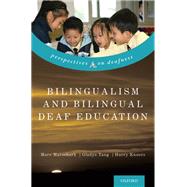
Bilingualism and Bilingual Deaf Education
by Marc Marschark; Gladys Tang; Harry Knoors-

This Item Qualifies for Free Shipping!*
*Excludes marketplace orders.
Rent Textbook
Rent Digital
New Textbook
We're Sorry
Sold Out
Used Textbook
We're Sorry
Sold Out
Summary
The volume offers both literature reviews and new findings across disciplines from neuropsychology to child development and from linguistics to cognitive psychology. With a focus on evidence-based practice, contributors consider recent investigations into bilingualism and bilingual programming in different educational contexts and in different countries that may have different models of using spoken and signed languages as well as different cultural expectations. The 18 chapters establish shared understandings of what are meant by "bilingualism," "bilingual education," and "co-enrollment programming," examine their foundations and outcomes, and chart directions for future research in this multidisciplinary area. Chapters are divided into three sections: Linguistic, Cognitive, and Social Foundations; Education and Bilingual Education; and Co-Enrollment Settings. Chapters in each section pay particular attention to causal and outcome factors related to the acquisition and use of these two languages by deaf learners of different ages. The impact of bilingualism and bilingual deaf education in these domains is considered through quantitative and qualitative investigations, bringing into focus not only common educational, psychological, and linguistic variables, but also expectations and reactions of the stakeholders in bilingual programming: parents, teachers, schools, and the deaf and hearing students themselves.
Table of Contents
Preface
1. Bilingualism and Bilingual Deaf Education: Time To Take Stock
Harry Knoors, Gladys Tang, and Marc Marschark
Part 1. Linguistic, Cognitive and Social Foundations
2. Language Development and Language Interaction in Sign Bilingual Language Acquisition
Carolina Plaza-Pust
3. Language Acquisition by Bilingual Deaf Preschoolers: Theoretical, Methodological Issues and Empirical Data
Pasquale Rinaldi, Maria Cristina Caselli, Daniela Onofrio, and Virginia Volterra
4. Bimodal Bilingual Cross-Language Interaction: Pieces of the Puzzle
Ellen Ormel and Marcel Giezen
5. Sign Language and Reading Comprehension: No Automatic Transfer
Daniel Holzinger and Johannes Fellinger
6. The Influence of Communication Mode on Language Development in Children with Cochlear Implants
Elizabeth Walker and Bruce Tomblin
7. Psychosocial Development in Deaf and Hard-of-Hearing Children in the 21st Century: Opportunities and Challenges
Manfred Hintermair
8. Bilingualism and Bimodal Bilingualism in Deaf People: A Neurolinguistic Approach
Ana Mineiro, Maria V?nia Silva Nunes, Mara Moita, S?nia Silva, and Alexandre Castro-Caldas
Part 2. Education
9. Navigating Two Languages in the Classroom: Goals, Evidence, and Outcomes
Marc Marschark and ChongMin Lee
10. Improving Reading Instruction to Deaf and Hard-of-Hearing Students
Loes Wauters and Annet de Klerk
11. Quality of Instruction in Bilingual Schools for Deaf Children: Through the Children's Eyes and the Camera's Lens
Daan Hermans, Loes Wauters, Annet de Klerk, and Harry Knoors
12. Shifting Contexts and Practices in Sign Bilingual Education in Northern Europe: Implications for Professional Development and Training
Ruth Swanwick, Ola Hendar, Jesper Dammeyer, Ann-Elise Kristoffersen, Jackie Salter, and Eva Simonsen
Part 3. Bilingual education in co-enrollment settings
13. Language Development of Severe to Profoundly Deaf Children Studying in a Sign Bilingual and Co-Enrollment Environment
Gladys Tang, Scholastica Lam, and Kun-man Chris Yiu
14. Social Integration of Deaf and Hard-of-Hearing Students in a Sign Bilingual and Co-Enrollment Environment
Kun-man Chris Yiu and Gladys Tang
15. Sign Bilingual and Co-Enrollment Education for Children with Cochlear Implants in Madrid, Spain: A Case Study
Mar P?rez Martin, Marian Valmaseda Balanzategui, and Gary Morgan
16. The Twinschool: A Co-Enrollment Program in the Netherlands
Daan Hermans, Annet de Klerk, Loes Wauters, and Harry Knoors
17. Co-Enrollment in the United States: A Critical Analysis of Benefits and Challenges
Shirin Antia and Kelly K. Metz
Epilogue
18. Perspectives on Bilingualism and Bilingual Education for Deaf Learners
Marc Marschark, Harry Knoors, and Gladys Tang
An electronic version of this book is available through VitalSource.
This book is viewable on PC, Mac, iPhone, iPad, iPod Touch, and most smartphones.
By purchasing, you will be able to view this book online, as well as download it, for the chosen number of days.
Digital License
You are licensing a digital product for a set duration. Durations are set forth in the product description, with "Lifetime" typically meaning five (5) years of online access and permanent download to a supported device. All licenses are non-transferable.
More details can be found here.
A downloadable version of this book is available through the eCampus Reader or compatible Adobe readers.
Applications are available on iOS, Android, PC, Mac, and Windows Mobile platforms.
Please view the compatibility matrix prior to purchase.
